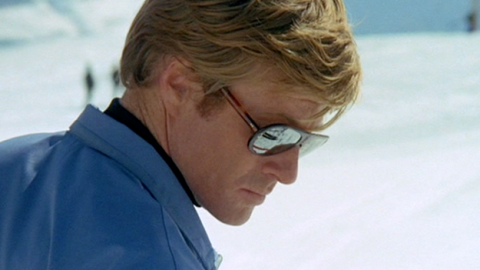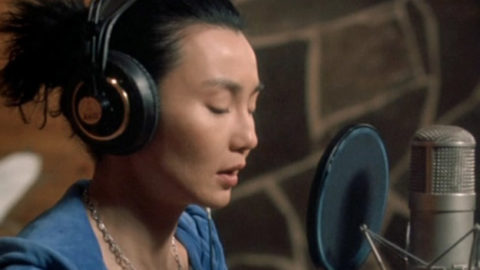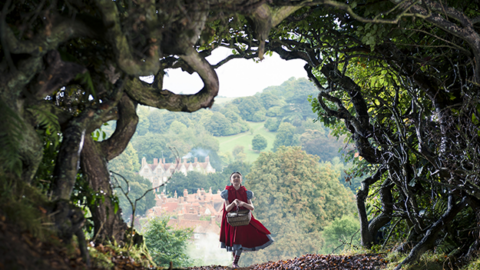Deep Focus: A Walk in the Woods
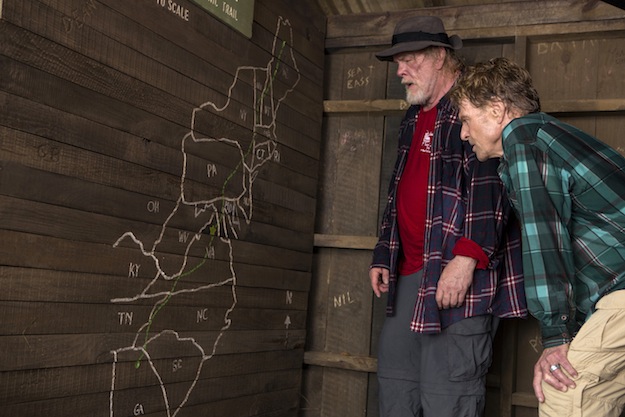
Watching Robert Redford and Nick Nolte play off each other—sometimes poignantly, sometimes lightheartedly—is the major lure of A Walk in the Woods, a hit-or-miss adaptation of Bill Bryson’s rollicking travel book about hiking bits and pieces of the Appalachian Trail with a ne’er-do-well companion. Redford, now 79, is the movie’s fictionalized Bryson, who was actually 44 when he started the trek. Nolte, now 74, is the rascally, out-of-shape, recovering alcoholic “Stephen Katz,” a pseudonym for an on-and-off Bryson pal who dates back to their school days in Des Moines. Redford, who is also a producer on A Walk in the Woods, originally hoped Paul Newman would play Katz. It could have been magical to see the reunion of these two old pros and friends. Nostalgia, though, might have swamped the fresh material and connected it too closely to the glamorous buddy movies (Butch Cassidy and the Sundance Kid, The Sting) that made them a box-office dream team. Redford and Nolte prove to be a fascinating, intermittently funny pairing. If the script had siphoned more of Bryson’s wry observations into “Bryson,” and if the director, Ken Kwapis, had come up with a richer comic vision of two weathered American males testing themselves against the primordial forest, the movie, unlike Bryson and Katz, might have made it to the finish line.
A Walk in the Woods starts promisingly, and hilariously, with Bryson hawking a boxed set of his books on Boston television. He’s confronted with the kind of interviewer who mistakenly thinks he deserves to be the center of attention as an ace conversationalist. Redford long ago mastered a witty version of appearing dumbstruck. It’s the perfect response to this wrong-way raconteur (played with gusto by Randall Newsome), who devalues Bryson’s travel writing by quoting Noel Coward song lyrics (“Why do the wrong people travel, travel, travel / When the right people stay back home?”). He even spouts details of Bryson’s biography—especially his two-decade residence in England—as if the writer were a fugitive or an anti-American expatriate. (Bryson was living in Hanover, New Hampshire when he started his walk; he’s since moved back to England for good.) It’s a pungent scene and a brisk way of filling in Bryson’s background. The details click together when we learn that, decades ago, Bryson had backpacked across Europe with Katz until the writer went to work at a British psychiatric hospital and fell in love with a nurse named Catherine (Emma Thompson). Bryson married, settled down, and raised a family while becoming an honored nonfiction writer. Katz stayed footloose but ended up back in Des Moines. He’s been striving to retain his adolescent joie de vivre ever since, living absurdly like an overgrown Fifties or Sixties juvenile delinquent, despite his bad knees and seizures and alcoholism.
Long ago, two paths diverged in a yellow wood—and these men diverged with them. Now they share a much greener wood and hope to stay on the same path for the duration of the trip. (Katz, who hopes for one last great adventure, was the only pal, estranged or otherwise, up for the trip.) It’s an apt setup for playing “getting to know you,” again. Does Bryson feel a twinge of longing for his carefree days with Katz? Does Katz regret extending his wild youth for half a century? The screenplay, credited to Rick Kerb and Bill Holderman (one of the producers), puts these questions into sitcom terms. You rarely feel that when these guys look at each other, they think, “There but for the grace of God go I.” They share a grumpy-old-men wariness as well as a penchant for uninhibited banter about subjects like Katz’s basement-level dating standards.
The movie follows a well-worn odd-couple formula, with Bryson walking the straight and narrow while Katz wobbles all over the place. It would be more jovial if Bryson weren’t always doing a manly, literary version of the Church Lady’s Superior Dance. Bryson teaches Katz that you can see all three types of rock (igneous, sedimentary, metamorphic) in a single cliffside. He explains that he gets this knowledge from books: “Television for smart people.” How dated is that quip? He says he enjoys collecting information because he’s curious. Katz counters that he’s a “Big Picture” guy who doesn’t wallow in details. You may feel Katz has a point.
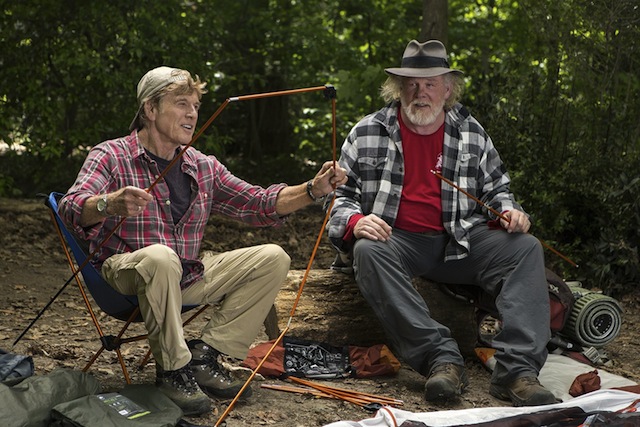
The movie’s Bryson, confoundingly, doesn’t see the forest for the trees. He wants such an immersive woodland experience that he forswears writing a book, though the real Bryson had bagged a contract before heading into the undergrowth. Instead of the down-to-earth bon vivant of Bryson’s travel-writing persona, mixing elegant tropes with profanity and slang, he seldom gets on a verbal roll and is more often sarcastic than witty. The one time he’s satiric about himself he says he spent the latter years “writing prefaces.” In the opening scenes, when his wife urges him to reconsider making this trek at his age, he appears to be in denial over his mid-life—in the movie, better make that late-life—crisis. He puts his foot in his mouth at a funeral, telling the widow “it’s a pleasure to be here.” (Another Redford specialty: looking abashed.) Later, it’s hard to tell whether it’s a symptom of malaise or just a passing holiday fancy when he enjoys flirting with a svelte, personable motel-keeper (Mary Steenburgen). She stirs him up just enough to make him call home right away. It’s as if Ron Burgundy whispers in his ear: “Stay classy.”
Katz is eager to charm an oversized woman while freeing her panties from the agitator in a laundry machine (he calls himself a “pantyologist” and an expert at removing them). He’s reckless enough to set up a rendezvous. The contrast between Bryson and Katz couldn’t be clearer. The movie wants to prove that their rekindled friendship overcomes all their differences, but it fails to balance what’s at odds in their makeup with what’s simpatico. Too often Bryson fights to tolerate Katz, whether Katz is crashing down on him from an upper bunk in a wilderness shelter (one of the movie’s mild exaggerations) or Bryson is discovering unopened whiskey in Katz’s pack. The movie is no canonization of St. Bill. But every time he screws up, it comes as a relief.
The movie version of Cheryl Strayed’s Wild sometimes leaned too heavily on narration; A Walk in the Woods could have used some. It’s refreshing to return to the book and enjoy how cheerfully Bryson ushers you into his “rationalizations” for the walk. The hike, he wrote, would work off years of “waddlesome sloth,” give him a chance to “reacquaint myself with the scale and beauty of my native land after nearly twenty years of living abroad,” and imbue him with “a little of that swagger that comes from being able to gaze at a far horizon through eyes of chipped granite and say, with a slow, manly sniff, ‘Yeah, I’ve shit in the woods.’” He wanted to experience “this singular wilderness,” roughly 2,180 miles from Georgia to Maine, before global warming turned it into “savanna.” Bryson’s voice is a droll, smooth version of Mark Twain’s, mixing frankness, hyperbole, and comic bluster. Without it, even when Redford pulls off an eloquent speech about the demise of the American chestnut, the movie simply stops short for a sermon. Even a limited use of voiceover would have enabled Redford, a master of reading text and playing subtext, to mine for laughs in the gap between Bryson’s churning brain and exhausted expressions. From Downhill Racer (69) to All Is Lost (13) and Captain America: The Winter Soldier (14), Redford’s originality and force have come from two rare qualities: an instinctive command over what not to play and an ability to make impassivity electric. That’s why, in his Sixties and early-Seventies heyday, he could be the perfect mainstream embodiment of the “no bullshit” side of the thriving counterculture.
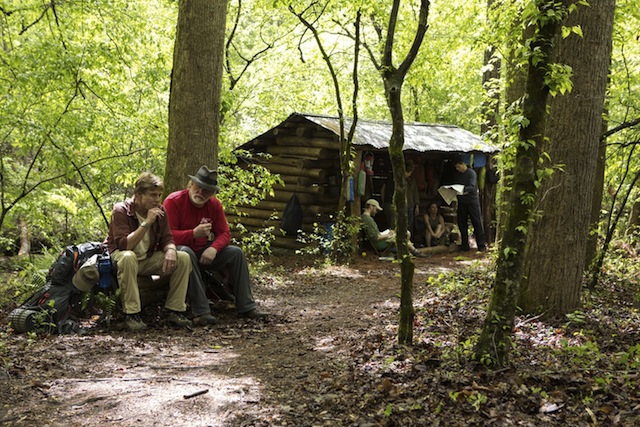
Nolte, just four years younger than Redford, became a movie star a decade later, and broke through as an actor in Karel Reisz’s Who’ll Stop the Rain (78), which depicted the death of the counterculture. Even when playing a merchant marine as an existential samurai in that film, Nolte was an actor of elemental, extroverted power. In the black-comic football expose, North Dallas Forty (79), Nolte persuasively embodied the downward slope of post-Sixties hedonism. He was more open-faced and open-hearted than Redford even when he wasn’t demonstrative or talkative, and he minted his own sloppy kind of gallantry in Walter Hill’s smash entertainment 48 HRS. (81) and Roger Spottiswoode’s top-flight political adventure Under Fire (83).
In A Walk in the Woods, it’s fun to watch the peerlessly canny Redford challenge Nolte in his let-it-all-hang-out mode. Though in TV spots Nolte can look as if he’s mugging, on the big screen you appreciate his lived-in details, like the mime show he puts on when explaining that he’s prone to seizures, or his sly display of intrigue when gauging a big gal’s erotic interest. The movie’s depth derives from Nolte, especially when Katz explains that he loves alcohol—giving it up leaves a big hole in his life. Although his performance as Katz is being compared to his superb farcical turn in Down and Out in Beverly Hills (86), it should lead viewers back to his magnificent portrayal of a recovering alcoholic in Gavin O’Connor’s Warrior (11). In that film he resembles a dormant volcano: he makes you hope against hope that he won’t pop.
Kwapis, a veteran film and TV comedy director, acclaimed for guiding the American incarnation of Ricky Gervais’s barbed sitcom The Office, spices the film with daft cameos from Nick Offerman as an omniscient REI salesman and Kristen Schaal as an annoyingly confident, frequently wrongheaded hiker. But he doesn’t fully exploit the incongruity that develops from the jocular squabbling taking place in miraculous settings. Kwapis brings little imagination or rhythm to his portrayal of the wilderness; he doesn’t even try to evoke the slapstick version of a Zen state that Bryson and Katz enter in the book. When these two wayfarers first experience the Great Smokey Mountains, Kwapis fails to root them inside the vista: they might as well be oohing and aahing against a green screen. Kwapis does conjure a strong climax: a mountain spill that plays like a realistic riff on the most memorable scene in Butch Cassidy—the one in which the Sundance Kid says, “I can’t swim” and Butch answers, “Are you crazy? The fall will probably kill you.” Bryson and Katz’s efforts to lower themselves down from a narrow ledge are as amusing and harrowing as their rueful vows of brotherly love are touching. Later, they convince you that they’ve earned the right to leave the trail.
Sadly, it’s a missed opportunity that their raison d’exit is vastly more persuasive than their raison d’être.



